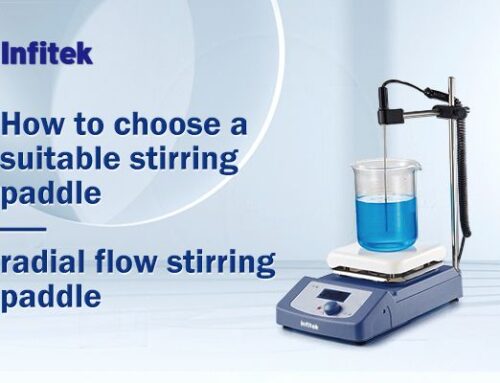Rotary evaporation is the process of reducing the volume of a solvent by distributing it as a thin film across the interior of a vessel at elevated temperature and reduced pressure. This promotes the rapid removal of excess solvent from less volatile samples. Most rotary evaporators have four major components: heat bath, rotor, condenser, and solvent trap. Additionally an aspirator or vacuum pump needs to be attached, as well as a bump trap and round bottom flask containing the sample to be concentrated.
Flask, Bump Trap, and Bath Temperature
Selecting a flask that accommodates approximately twice the starting volume. If proper caution is exercised, the volume of the bump trap is irrelevant, but one should always be used as it prevents you from having to recover your sample from the condenser and solvent trap if bumping occurs. A low-vac pump or sink aspirator and temperatures between 25 and 50°C suffice for most common lab solvents. Lower temperatures make for a slower process but reduce the likelihood of bumping. Use common sense when selecting a temperature unless you lack common sense or are crippled with self doubt. In such a case a manometer and distillation nomograph can be utilized.
How to Commence a Rotary Evaporation
Let the heat bath get hot and the condenser get cold. The inverse situation often yields suboptimal results. Empty the solvent trap given that the previous user almost certainly did not. Take care when the trap is filled with unknown solvent as almost invariably the previous user left it brimming with pyridine or trifluoroacetic acid.
Secure the bump trap and sample flask using clamps. Alternatively, see the page on how to extract 5 mg of advanced intermediate from several liters of algae-infested hard water.
Activate the rotor. It should spin fast enough to create an even coating on the inner surface of the flask. Use this time to study the effects of coriolis force.
Activate the vacuum pump. Close the stopcock on the condenser to the point where you can no longer hear it whistling, but that there is an audible “pop” if you cover and release it with your thumb. Allow the sample to spin under vacuum for approximately a minute. Very likely it will soon begin to boil. Don’t panic. Boiling is not the same as bumping. As long as the bubbles do not reach the neck of the flask it may be allowed to boil. If the bubbles do reach the neck you have allowed it to bump: congratulations. If the bubbles seem to be in danger of reaching the neck, repressurize the system by fully opening the stopcock to cease boiling. Repeat until boiling has ceased and solvent is steadily streaming from the condenser; only then do you fully close the stopcock. When condensation begins to form on the exterior surface of the flask, lower it into the heat bath approximately half way.
Continue to monitor the situation for another minute or two. If there is danger of bumping, open the stopcock. Once again, repeat until boiling has ceased and solvent is steadily streaming from the condenser. At this point it is safe to leave the rotary evaporator unattended.
Occasionally check to ensure nothing has gone heinously wrong.
How to Halt a Rotary Evaporation
Remove the flask from the heat bath.
Open the stopcock.
Halt the rotor.
Turn off the vacuum/aspirator.
Disconnect the flask.
Drop flask in heat bath.
Hope that you serendipitously extract the cure for cancer from the crud in your heat bath.
Omission of any of these steps may result in an undesired outcome, e.g: filling the rotary evaporator with tap water when turning off the aspirator before opening the stop cock, bulk transport of your sample into the deepest recesses of the rotary evaporator when disconnecting the flask before opening the stopcock, and broken glassware as well as lacerations and the derision of fellow lab members when attempting to remove the flask before halting the rotor.
If at any point in this process bumping occurs, remove the flask and bump trap as a unit and rinse the interior with several mL of solvent. If your trap has drain holes the sample will flow back into the flask. Depending on the configuration of you trap, if it lacks drain holes you may have a Gordian monstrosity on your hands.
When you have finished your rotary evaporation do not empty the solvent trap, that is for suckers. So is washing and drying the bump trap.
Reagent/solvent-specific Considerations
Care should be taken to avoid damaging the pump and/or releasing toxic volatiles into the lab atmosphere. Acids and chlorinated solvents do not belong in your lungs, and even if you don’t mind/care, I guarantee that your lab-mates will. Be aware that in some cases (expecially for highly volatile liquids) not all of the solvent removed on the rotovap will condense in the traps. You can try venting through a fume hood if the apparatus is in an appropriate position, if not attach a scrubber filled with paraffin oil.
If you really must remove corrosive materials such as propionic/acetic acid, make sure you attach a second liquid nitrogen trap before the solvent passes through the vacuum. This will prolong the life of the pump.
Some solvents/reagents are not really suitable for rotary evaporation, unless the exhaust from your vacuum pump is vented into a fume hood. Pyridine is one. Try extracting it out instead (dilute HCl will help), or remove in vacuo in your fume hood. The spermies of the males in your lab are susceptible to pyridine and you don’t want an accidental leak of this fertility-killing stuff.
Lastly, be aware of any potentially reactive solvent combinations. Thionyl chloride and water is a good example. If you really must take off thionyl chloride on the rotovap (there are better alternatives!) be aware that if your apparatus contains moisture you may end up with a nasty stream of HCl/SO2 gas coming from the pump, a combination that is both bad for the pump, and bad for the unfortunate souls who share a lab with you.




Get Social